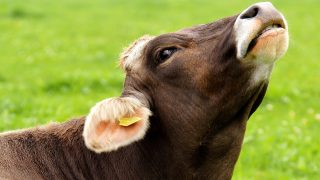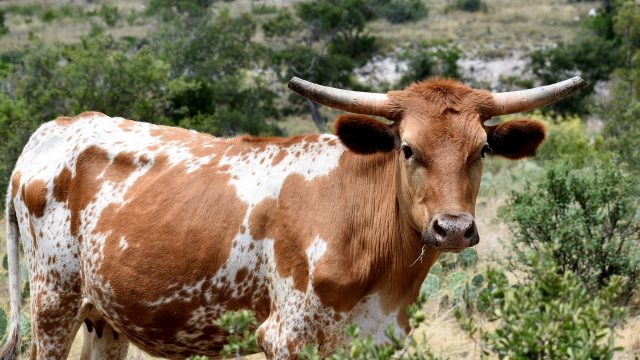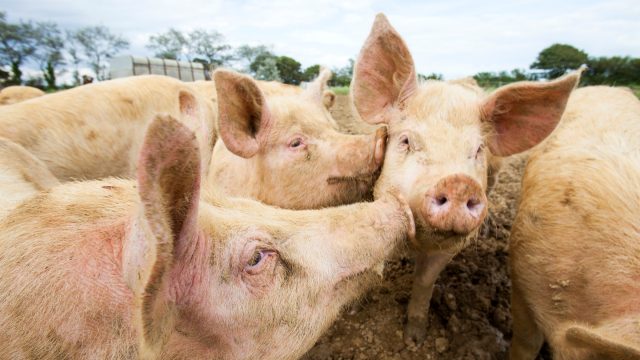
Kosher Slaughter Laws and an End to “Shackle-and-Hoist” Restraint
In December 2014, the Polish Constitutional Tribunal invalidated a 2013 law in that country that required that animals be stunned prior to slaughter—which renders cows and other animals insensitive to pain before their killing blows are dealt. In enacting the now-invalid stunning mandate, Poland had joined Sweden, Norway, Denmark, Switzerland, Liechtenstein, and New Zealand in indirectly prohibiting kosher slaughter: the kosher ritual, or shechita, requires that animals be healthy and uninjured prior to slaughter, and thus, stunning renders the animals—according to interpretation—unfit for kosher consumers. Unfortunately, this apparent conflict has led countries, including the United States, to broadly exempt kosher slaughterhouses from all humane requirements and to permit cruel practices like “shackle-and-hoist.”
Shackle-and-hoist is a common method of restraining animals for shechita. In this horrific practice, a slaughterhouse employee places an iron shackle around one of the still-conscious animal’s rear limbs, then hoists the steer into the air where he hangs upside-down by a chain, desperately thrashing and bellowing until slaughter. This cruel method of restraint inflicts broken bones, snapped tendons, and intense pain and stress. In most slaughterhouses, shackle-and-hoist is illegal unless the animals are first rendered insensible to pain. Shamefully, when it comes to ritual slaughter, U.S. law not only permits shackle-and-hoist but also considers it “humane.” This absurd exemption exists despite the fact that the kosher ritual does not require shackle-and-hoist. Many Jewish groups and authorities have even condemned the practice as a violation of tsa’ar ba’alei chaim, the prohibition against causing unnecessary suffering to living creatures.
While the most humane choice is always plant-based alternatives to slaughtered animals, most experts agree that kosher slaughter, when performed correctly, is at least as humane as pre-slaughter stunning. What does this look like? In short, shechita is performed correctly when a shochet (a specially trained Jewish male) severs the animal’s carotid arteries with a knife that is surgically sharp and without imperfection, causing the animal to lose consciousness instantly. Dr. Temple Grandin, one of the foremost authorities on humane slaughter practices, insists that animals slaughtered under optimal conditions show little or no stress reaction to the ritual cut before losing consciousness.
Conditions in kosher slaughterhouses, however, are very rarely optimal. Indeed, despite the availability of more humane restraint alternatives, such as upright restraint pens, shackle-and-hoist remains the primary restraint method in South American kosher slaughterhouses, which produce most of the world’s kosher beef. In 2010, a PETA investigation uncovered horrific cruelty, including the use of shackle-and-hoist restraint, in a kosher slaughterhouse in Uruguay.
Religious groups reasonably view laws like Poland’s effective ban on kosher slaughter as oppressive. On the other hand, laws that grant kosher slaughterhouses the broad authority to shackle-and-hoist conscious animals wrongly assume that the kosher ritual is unachievable without cruel handling. The truth is, it is possible to promote humane handling and respect religion by holding kosher slaughterhouses accountable to basic standards of humane handling to the greatest extent practicable without requiring pre-slaughter stunning. Much of ALDF’s legal work is to address the glaring absence of legal protection for farmed animals. This means, at the least, prohibiting the most cruel slaughterhouse practices, like shackle-and-hoist restraint.
Focus Area
Related
-
$5,000 Reward for Information Regarding Six Killed and Mutilated Cows in Three Texas Counties
Cows were killed in Madison, Brazos, and Robertson Counties, Texas.May 3, 2023 Press Release -
Fourth Circuit Enjoins North Carolina Ag-Gag Law
The U.S. Court of Appeals for the Fourth Circuit handed an important win to plaintiffs in a lawsuit challenging North Carolina’s Ag-Gag law, ruling that undercover investigations and whistleblowing are considered newsgathering activities protected by the First Amendment.February 23, 2023 Press Release -
Court Strikes Down Second Iowa Ag-Gag Law
Public interest coalition celebrates another win against unconstitutional statute barring undercover investigations at factory farmsMarch 15, 2022 Press Release



